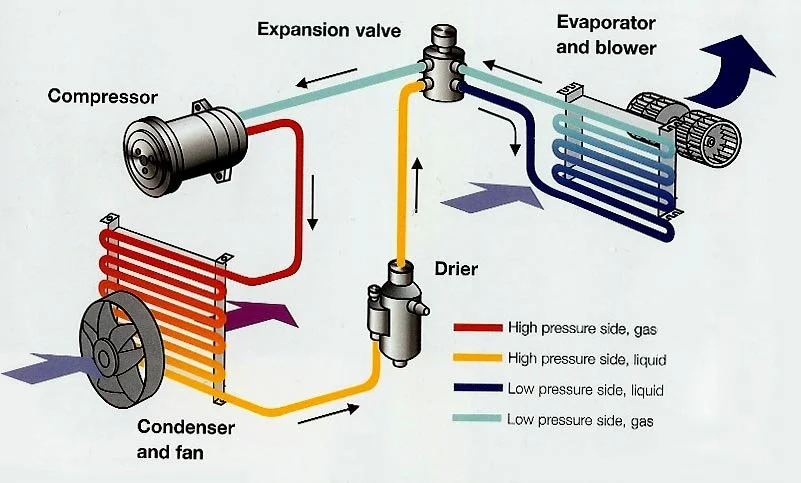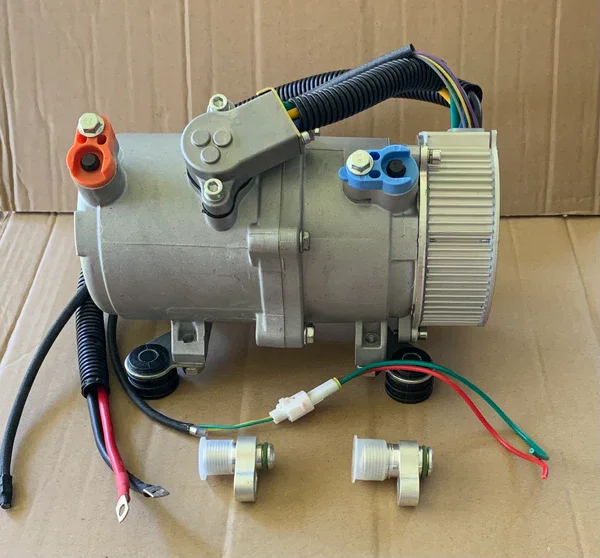UNDERSTANDING ELECTRIC A/C
Fat-lapping old cars is great fun, but summer cruising in Australia can be a brutally hot, sweaty affair. While aftermarket air conditioning has been around for a fair while a lot of project cars don't have space on the engine for an A/C compressor - thankfully there is a solution to that which means all project cars can now enjoy frosty cold A/C, making for comfier passengers and better enjoyment of what can be a family sport.
Electric compressors are used in EVs and truck sleeper cabs, and they replace traditional engine-mounted belt-driven compressors. The placement of engine-mounted compressors is critical, and they are often the first things removed when engine bay space is at a premium.
Here is how car air conditioning works: refrigerant gas is used in a pressurised system where a compressor pumps it through a system of cores with fans. As it is heated and cooled it changes between a gas and liquid, and the cold liquid has air blown across it, which becomes the lovely cold air blowing out the vents in your dashboard.
Electric air conditioning compressors do have some drawbacks, most notably the electrical draw they pull when going flat-out. A 21cc compressor, which is the size you’d need to effectively cool a medium-to-large sedan, will draw 100-amps at peak demand.
These compressors also need to be as close to the condenser core and drier as possible to maintain maximum cooling efficiency, which is why I mounted the electric compressor in my LS-swapped ‘64 Pontiac behind the right-hand headlight. You can see it in the image below, and a side benefit to placing the compressor here (instead of being hidden completely from sight) is I can still access it easily to service the system.
The other compromise with fitting aftermarket A/C to a vintage car is the amount of space you’ll sacrifice. My Vintage Air Gen IV Magnum evaporator takes up literally half the space under the dash and has left me no space for the stock ashtray or glovebox. Even fitting the ducting for the A/C vents becomes tight, so you need to plan out your accessories, be prepared to compromise, and get creative.
In the photo below you can see the Vintage Air evaporator hanging down below the dash. It’s tucked hard into the available space in that area, but this is the clearest indicator of just how large an appropriately-sized aftermarket evaporator is in a street car. However, being able to cruise with heat in winter and cold air in summer is key, plus the Vintage Air evaporator also has outlets for a front demister. The ability to prevent the windscreen from fogging is a key safety item for anyone wanting to drive their project!
I had to fit an electric compressor to my car due to one main factor: space. The shape of my Pontiac's crossmember and the extra idlers needed for the supercharger belt meant I couldn't fit an air conditioning compressor on the engine. Having A/C in my classic car is a must for me, as I want to drive my car year-round and do so in comfort, and so i had to look to other options.
The pic below isn’t great but it shows the deep Vee in the crossmember, and its the sides of this welded-in part of the chassis which saps all the space for a low-mount A/C compressor.
I soon found THIS REMOTE-MOUNT compressor at Speedy Air Spares. I sourced the lines, condenser, and drier for the Vintage Air set-up from Speedy, so I gave him a call and he advised the 21cc compressor would be the right size for what I wanted, and that my massively oversized alternator would be able to handle the draw.
The screw-on MIOR fittings and Speedy's DIY hoses make it easy to put a whole A/C system together at home, which you can then simply get gassed by a professional later on.
The rest of my system is the same as any conventional A/C system, which means that if you want to engine-swap a car which already has A/C but don’t have space for a compressor on the new engine you should have a look at an electric compressor.






